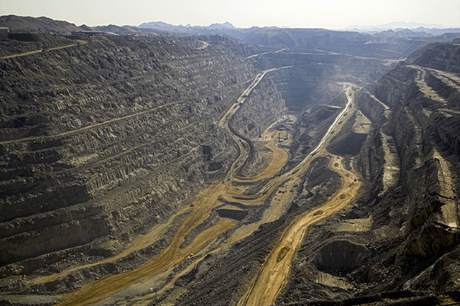Rössing plans for desalination
05 August 2014
Rössing Uranium is planning to build a new desalination plant to ensure an economical source of water for its uranium operations in Namibia. The move follows an organizational restructuring as the company strives to improve economic viability at one of the world's top-producing uranium mines.
 |
| Rössing's open pit (Image: Rio Tinto) |
Water supplies in the Erongo region of Namibia, where Rössing is located, are very limited. Since last November, Rössing has been using water supplied from a desalination plant built by Areva in anticipation of the startup of its own uranium mining operations at Trekkopje, through a contract with the state-owned Namibia Water Corporation (NamWater). Areva put plans for Trekkopje on hold in 2012, but decided to keep the desalination plant open. However, Rössing says that it has not been able to agree "economically feasible terms" for long-term supplies from the Areva plant.
NamWater has plans for a desalination plant of its own in the region, launching an environmental impact assessment process in 2009, but the outcome and timelines of that project remain uncertain. The situation has prompted Rössing to look into securing an alternative source of desalinated water to ensure the commercial sustainability of its uranium operations.
Rössing's desalination plant would be located about 6 km north of the town of Swakopmund, at the site of the existing Swakopmund Salt Works. The plant would purify pre-treated seawater through a modular reverse osmosis plant with a capacity of about 3 million cubic metres per year. The project will also require the construction of 6 km of 11 kV power line, a water supply line of about 850 m to carry desalinated water to NamWater's existing pipeline, and other associated infrastructure.
The company has now launched a social and environmental impact assessment for the project, which it expects to complete by January 2015. The plant itself would take 12-18 months to complete once environmental clearance is granted by Namibia's Ministry of Environment and Tourism.
Rössing has not been immune to the adverse market conditions that prompted Areva's decision to postpone Trekkopje. In June, the company announced an organizational restructuring to enable it to continue operating, including a change to a five-day operating cycle and a revision of mining and milling targets and reducing its workforce from 1168 to around 930. Going into effect on 1 August, the new plan sees Rössing limit its output to only produce sufficient uranium to meet existing long-term contracts. The company says this will make it insensitive to fluctuations in the uranium spot price, and enable it to avoid care-and-maintenance or closure.
Rössing ranked tenth in the list of the world's top producing uranium mines in 2013, with its output of 2031 tU representing around 3% of world uranium production.
Researched and written
by World Nuclear News